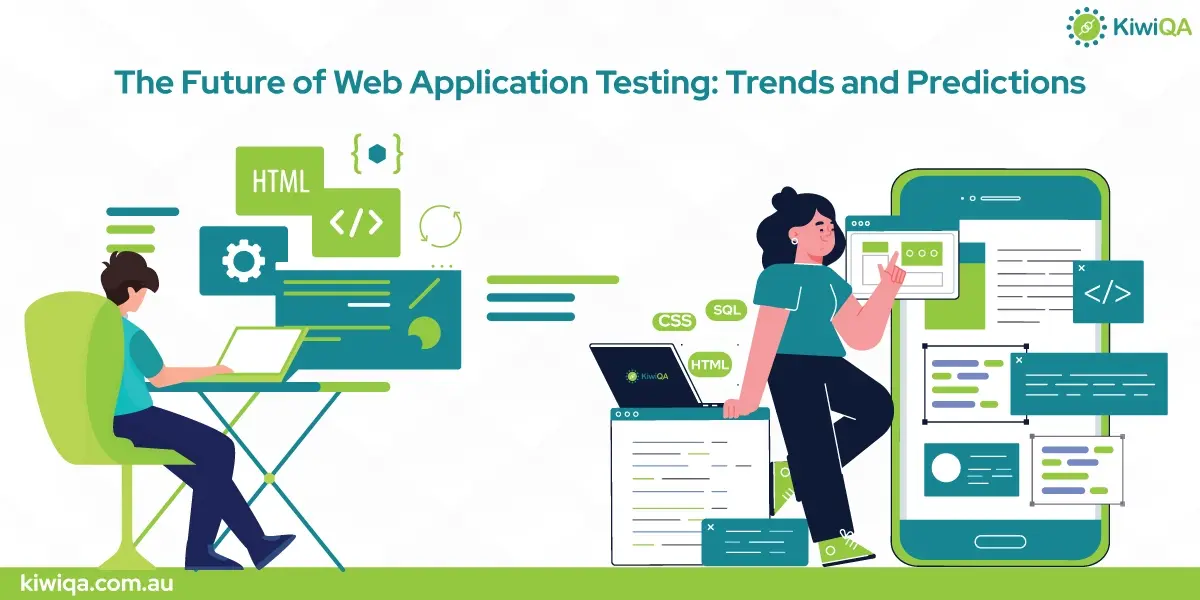The Future of Web Application Testing: Trends and Predictions

 KiwiQA
KiwiQATesting is a crucial necessity for every business that creates and deploys web applications or websites. Web application testing is an important practice in software testing, which ensures that a web application performs according to the desired specifications. As of now, web application testing is an important tool for businesses that aim to strengthen their online presence.
Effective web application testing can help in identifying flaws such as integration issues, functional inconsistencies, and security breaches. However, the web application testing landscape is evolving gradually, with a growing emphasis on automation.
The evolution of web application testing has created the need to learn about the emerging trends in web app testing. Website testing is essential for developing new features without compromising with user experience. The emerging trends in web application testing services can enable the detection of product defects and security issues within a limited time. Most important of all, developers and testers can leverage new trends to stay ahead of the curve.
One of the best ways to understand the significance of emerging trends in web application testing is to reflect on its history. The first piece of software was written in early 1950, which performed mathematical calculations by using machine code instructions. Initially, debugging played a crucial role in the software testing process.
In 1957, quality assurance testing became an important highlight in the Software Development Lifecycle. However, debugging was separated from testing for software development in 1979. Subsequently, the first testing tool arrived in 1985, and software quality engineering emerged in 1986; with the major improvements in approaches for software quality testing, the existing era focuses on the use of automation, cross-browser testing tools, and AI.
The evolution of web application testing is not all about new technologies and automation. You should also consider the changes in approaches to web application testing over the years. For example, businesses had to focus on preparing their web application for one or two browsers.
On top of that, web application testing was generally the last priority in the release checklist. In addition, manual testing was the norm, which slowed down the arrival of new products in the market and also offered little test coverage.
However, current practices for web application development leverage JavaScript frameworks that offer more testing combinations. In addition, the current practices for web application testing also focus on addressing testing complexity and browser fragmentation. Most important of all, existing practices for web application testing also revolve around achieving full test coverage through automated testing.
AI and machine learning showcase exceptional promise for integration in automated testing procedures for improving competence, efficiency, and dependability of test scripts. AI and ML can improve web application testing by offering crucial advantages in terms of time and test script coverage. For example, AI tools can help in faster and more automated generation of test scripts. At the same time, AI and ML tools could help in using auto-healing techniques for navigating through modifications to ensure execution of test scripts with minimal conflicts.
Artificial Intelligence is an emerging trend with the potential for inducing change on a massive scale in web application testing. One of the most noticeable outcomes of using AI in web application testing refers to the changes in test automation and analysis. The applications of AI and ML in test automation involve the use of algorithms for predicting potential issues through analysis of historical test data.
The predictive capability of AI can help test engineers in including a comprehensive range of faults in the test scripts, thereby enabling better detection. In addition, AI-powered test automation also improves test automation by generating and prioritizing test cases according to user activity.
Shift-left testing is also an emerging trend in the domain of web application testing. It offers crucial value advantages for test engineers by offering flexibility for performing the testing process at an early stage of the software development lifecycle. Shift-left testing helps in addressing the concerns with the conventional approaches to web application testing, such as delay in bug detection and higher costs.
The shift-left testing approach revolves around proactive collaboration between development and testing teams. It helps in earlier detection of bugs in the software development lifecycle. As a result, you can have high-quality code while saving time and money.
Web application testing must start in the early stages of the software development lifecycle. It is a useful strategy for identifying and eliminating defects in the early stages of SDLC to reduce the number of defects. The promising advantages of early testing in the SDLC point to support for stabilization of the code and minimizing collateral resulting from bug fixes. Most important of all, early testing also helps in extension of test coverage alongside efficient distribution of development and testing resources.
Security testing is a non-functional testing approach that focuses on verifying the correct configuration or design of an application. It focuses on checking whether a web application is vulnerable to security threats. In addition, security testing is an important tool for verifying the impact of unexpected or malicious inputs on operations of the web application.
The growing focus on security testing primarily revolves around the objective of checking whether web applications are safe and reliable. The most prominent aspects emphasized in security testing include confidentiality, non-repudiation, integrity, availability, authentication, and authorization.
Web application testing has become an important and reliable tool for defense against emerging cyber-attacks. As the importance of cybersecurity comes into the limelight, especially in the domain of web applications, it is important to reflect on how security testing serves value advantages.
Web application testing approaches focus on cybersecurity to gain the trust of users and ensure seamless functionality. Effective and comprehensive security testing helps ensure the development of risk management strategies alongside other value advantages.
5G is the next big connectivity technology in the market. Interestingly, it would also have a massive impact on different domains of web application testing. For example, it can improve network connectivity with the rise of new test environments tailored for better speed and performance. 5G can also help in improving precision in security testing and requires modifications in the conventional approaches to software testing.
New technologies like 5G connectivity have introduced a major paradigm shift in web application development and testing. The benefits of faster connectivity, enhanced network capabilities, and lower latency help in testing web applications at a faster pace with real-time data processing.
5G networks can establish unified connections without any blockades in the network. In addition, the impressive speed of data upload and download also offers improvements in speed.
IoT and web application integration is another prominent challenges faced in testing web applications. You might wonder about the reasons why IoT has become a crucial priority for testing web applications. IoT is one of the most popular technologies that has been growing with the rise of 5G and other connectivity technologies. Furthermore, the use of IoT across different industries has created the need for embedding IoT with web applications for different use cases.
While IoT has become an important highlight in the domain of web application development, it also creates challenges for testing. Some of the crucial challenges for testing IoT-integrated web apps include complexity and diversity of IoT devices, security concerns, data privacy, interoperability, and scalability.
For example, IoT systems include different devices with their unique features and capabilities. On top of it, testing of IoT-integrated web apps also demands a combination of hardware and software testing. The best approaches for addressing the challenges of testing IoT-integrated web apps involve a detailed testing strategy.
In addition, it is also important to rely on collaboration between web application testers with diverse expertise for testing across different aspects of IoT systems.
Cloud-based testing solutions are the next big thing in the domain of web application testing. It revolves around verification of software quality in cloud environments. It helps in accessing multiple real mobile and desktop devices for real-time testing of web apps. The hosting of devices on cloud-based servers enables their accessibility at all times.
Cloud-based testing solutions support the effective implementation of automated testing. For example, cloud infrastructure could offer simultaneous tests for multiple teams and users on different devices. Cloud-based testing environments also offer faster testing without compromises in terms of accuracy.
Cloud platforms have become an important highlight in modern web app testing environments for different reasons other than effective automated testing. The rise of cloud platforms in testing environments would point to the benefits of using cloud infrastructure for testing. For example, cloud platforms could help in creating testing environments that closely resemble the production environment.
Cloud platforms can help in optimizing test environments with the essential hardware-software configurations. In addition, QA teams could test from different sources and app testing workflows alongside extending device coverage. The rising adoption of cloud platforms in testing environments has opened the route for web app testing on cross-platform mobile devices.
User experience or UX testing is an important highlight for a user-centric design that focuses on testing usability. UX testing or usability involves testing a product on real users or a sample of the target audience. It involves evaluation of UX of a web application. Test participants would have to complete specific tasks with a web application, and designers would determine the ease of completing the tasks without any prior knowledge of the applications. UX testing provides clear insights into the intuitiveness of the existing design and also helps in identifying usability issues.
User experience is an essential element for designing web apps that meet the needs and preferences of the end users. The success of a web app depends on providing a positive user experience, such as offering a solution for the user’s pain points or answering their queries.
User experience can also be associated with something as trivial as discovering a product page on the web app or searching for specific information on the app. UX also focuses on delivering more than what you promise to the user with your web app. For example, users may visit a web app to buy some products and learn something new about topics on environmental sustainability or new technology trends.
Predictive analysis involves the use of historical data for prediction of unknown events. The prediction process leverages multiple technologies, such as artificial intelligence, machine learning, statistical modeling, and more. Interestingly, predictive analytics can help in predicting unknown security issues and defects with web apps during the testing process. Software development and testing teams could utilize predictive analytics for accurate prediction of product usage patterns.
Predictive models could offer a new perspective on designing testing strategies. Rather than emphasizing the business and functional requirements, testing teams could use predictive models to find whether web applications meet the expectations of end users. Predictive analytics models could shape testing strategies through optimization of resource management, prediction of potential bugs, and streamlining testing activities. Predictive models can also help in effective understanding and prediction of user behavior for making data-driven decisions to improve usability.
Cross-platform testing is another prominent addition among new technologies in the domain of software testing. It is necessary for web application testing to offer a high-quality and consistent user experience across different platforms. The necessity of a comprehensive cross-platform testing strategy focuses on its use for finding how an application performs on all platforms. Users not only focus on the usability of a web application but also focus on the layout, functionality and design across different browsers.
The need for comprehensive cross-platform testing strategies draws attention to the benefits of cross-browser tests for web apps. First of all, testing teams could use cross-platform testing strategies for testing the functionality of the web app on popular browsers.
Cross-platform testing strategies focus on different elements such as base functionality, responsiveness, design, and accessibility. The strategies ensure that your web app offers all the base functionalities on different browsers and device platforms. Cross-platform testing strategies ensure that the web app design can fit different screen sizes and offer a fluid experience on all devices.
The rise of new trends and technologies in the domain of software testing requires testers to develop new skills and knowledge. If you decide to pursue a career in web application testing, then you must develop the important skills required to address your job responsibilities.
The important skills that testers need to stay relevant in the future of web application testing include AI and ML, automation testing, analytical skills, proficiency in programming languages, and effective communication skills. On top of it, you would also have to earn skills in domain-specific testing, test automation, and test documentation.

The evolution of software development and testing has led to the rise of new approaches such as Agile and DevOps. Agile refers to an iterative approach focused on customer feedback and collaboration. It is helpful for adapting to changing market conditions and consumer behavior. DevOps is also another software development approach that involves collaboration between the development and operations teams for creation, deployment, and management of applications.
Adaptability is the core requirement for success in a time when customer behavior changes within minutes. The most popular trends in web applications could become obsolete in the next year. At the same time, customer demand could increase for a specific solution, thereby demanding better scalability. Amidst the wave of changes and fluctuations in the market, web application testing must also rely on adaptability for responding to the changing conditions.
The final recommendation to prepare for the future of software testing revolves around investments in advanced testing tools. You should take note of the most effective automation testing tools, such as Selenium, and their value advantages for web application testing.
It is important to stay updated with the latest tools and technologies to overcome the limitations associated with traditional tools. You should choose automated testing tools and technologies that can offer cross-browser support, templates for creating test scripts, and intelligent automation.
The knowledge of new tools and technologies could help testers achieve a competitive advantage in creating successful web applications.
The overview of the emerging trends in web application testing showcases that new technologies have changed the conventional approaches to software testing. For example, testing teams could utilize AI and machine learning to improve automation of the process for generating test scripts. Testing teams could focus on specific problems for creation of test scripts that evaluate web apps for the capability to address concerned problems.
Web application testers and developers must also understand that they have to stay updated with the latest trends and technologies. It helps them stay relevant in the future and contribute to the creation of effective web applications tailored to user requirements. Testers should focus on learning about new web application testing tools and methodologies alongside embracing adaptive methodologies in testing.
Web application testing has evolved from the conventional approaches to ensure promising improvements. Users demand more responsive web application quality assurance of security and advanced features that work on all devices and browsers. Therefore, it is time to transform your web testing approach with comprehensive training and skill development for the future of web application testing.
Take the initiative to become a part of the future by participating in software testing communities and professional training. You can rely on recommendations from industry experts to improve your approaches to testing. The best practices for continuous learning can also help you develop essential skills required for web application testing.
Subscribe to our newsletter for some hand-picked insights and trends! Join our community and be the first to know about what's exciting in software testing.
Welcome to the testing tales that explore the depths of software quality assurance. Find valuable insights, industry trends, and best practices for professionals and enthusiasts.

Fill out and submit the form below, we will get back to you with a plan.
 CRN:
22318-Q15-001
CRN:
22318-Q15-001 CRN:22318-ISN-001
CRN:22318-ISN-001 CRN:22318-IST-001
CRN:22318-IST-001